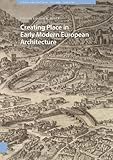Creating Place in Early Modern European Architecture / ed. by Elizabeth Merrill.
Material type: TextSeries: Visual and Material Culture, 1300 –1700 ; 32Publisher: Amsterdam : Amsterdam University Press, [2021]Copyright date: ©2021Description: 1 online resource (376 p.)Content type:
TextSeries: Visual and Material Culture, 1300 –1700 ; 32Publisher: Amsterdam : Amsterdam University Press, [2021]Copyright date: ©2021Description: 1 online resource (376 p.)Content type: - 9789048550814
- 724 23
- online - DeGruyter
| Item type | Current library | Call number | URL | Status | Notes | Barcode | |
|---|---|---|---|---|---|---|---|
 eBook
eBook
|
Biblioteca "Angelicum" Pont. Univ. S.Tommaso d'Aquino Nuvola online | online - DeGruyter (Browse shelf(Opens below)) | Online access | Not for loan (Accesso limitato) | Accesso per gli utenti autorizzati / Access for authorized users | (dgr)9789048550814 |
Frontmatter -- Visual and Material Culture, 1300-1700 -- Table of Contents -- List of Illustrations -- Abbreviations -- Introduction: Embracing Specificity, Embracing Place -- 1. Architecture on Paper : The Development and Function of Architectural Drawings in the Renaissance -- Part I. Marking Place -- 2. The Santacroce Houses along the Via in Publicolis in Rome: Law, Place and Residential Architecture in the Early Modern Period -- 3. Towards a New Architecture of Cosmic Experience -- 4. Architecture for Music : Sonorous Spaces in Sacred Buildings in Renaissance and Baroque Rome -- Part II. Teaching Place -- 5. The Spedale di Santa Maria della Scala and the Construction of Siena -- 6. Places of Knowledge between Ulm and the Netherlands in the Seventeenth Century : The Kunstkammer of Johannes Faulhaber -- 7. Nicola Zabaglia’s Scaffoldings for the Maintenance of Architectural Space in St. Peter’s Basilica and throughout Europe in the Seventeenth to Nineteenth Centuries -- Part III. Excavating Place -- 8. Building on ‘Hollow Land’ : Skill and Expertise in Foundation-Laying Practices in the Low Countries in the Fifteenth to the Seventeenth Centuries -- 9. The ‘Conquest’ and Construction of an Urban Place : The Insula dei Gesuiti in Venice in the Early Modern Period -- 10. Exploring the Book of Fortresses -- Index of Names -- Index of Subjects and Places
restricted access online access with authorization star
http://purl.org/coar/access_right/c_16ec
The importance of place—as a unique spatial identity—has been recognized since antiquity. Ancient references to the ‘genius loci’, or spirit of place, evoked not only the location of a distinct atmosphere or environment, but also the protection of this location, and implicitly, its making and construction. This volume examines the concept of place as it relates to architectural production and building knowledge in early modern Europe (1400-1800). The places explored in the book’s ten essays take various forms, from an individual dwelling to a cohesive urban development to an extensive political territory. Within the scope of each study, the authors draw on primary source documents and original research to demonstrate the distinctive features of a given architectural place, and how these are related to a geographic location, social circumstances, and the contributions of individual practitioners. The essays underscore the distinct techniques, practices and organizational structures by which physical places were made in the early modern period.
Mode of access: Internet via World Wide Web.
In English.
Description based on online resource; title from PDF title page (publisher's Web site, viewed 03. Jan 2023)


